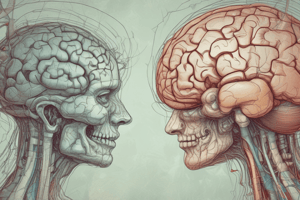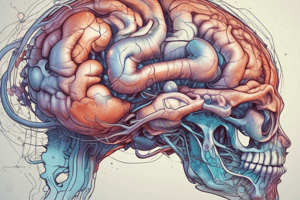Podcast
Questions and Answers
What is the primary function of electroencephalography (EEG) in animals?
What is the primary function of electroencephalography (EEG) in animals?
- To study diffusion and structural tension in brain images
- To record extra-cellular activity using single-cell membrane (correct)
- To measure temporal motion and magnetism
- To examine blood oxygenation levels and neuronal activity
What is the term for the process of converting sensory information into neural signals?
What is the term for the process of converting sensory information into neural signals?
- Reception
- Transduction (correct)
- Coding
- Synaptic transmission
Which theory is related to the integration of features in visual perception?
Which theory is related to the integration of features in visual perception?
- Atkinson and Shiffrin's theory
- Chomotopsia
- Balint's Syndrome
- Feature integration theory (correct)
What is the term for the study of the directional flow of water molecules in brain tissue?
What is the term for the study of the directional flow of water molecules in brain tissue?
What is the primary function of transcranial magnetic stimulation (TMS)?
What is the primary function of transcranial magnetic stimulation (TMS)?
What is the term for the inability to integrate visual information into a coherent percept?
What is the term for the inability to integrate visual information into a coherent percept?
What is the term for the neural pathway involved in motor control and spatial awareness?
What is the term for the neural pathway involved in motor control and spatial awareness?
Flashcards are hidden until you start studying
Study Notes
Consciousness and Stimulus-Driven Processes
- Consciousness involves both prior knowledge and stimulus-driven responses.
- Unconscious processing plays a significant role in behavioral measurements using EEG techniques.
- Measurements involve electrodes placed inside (intracellular) and outside (extracellular) axons.
EEG and Brain Imaging Techniques
- Single-cell membrane recording is often used in animal studies to capture neural activity.
- Magnetic fields generated during brain activity can affect temporal motion and realignment, which is essential for understanding neural processes.
- Diffusion Tensor Imaging (DTI) and MRI are used to study structural connections within the brain, focusing on the diffusion of water molecules in relation to brain regions.
Blood Oxygen Level-Dependent (BOLD) Signals
- BOLD fMRI measures brain activity by detecting changes in blood oxygenation levels; higher activity in neurons requires more oxygen.
- The relationship between active regions of the brain and increased blood flow is crucial for understanding brain function.
Transcranial Magnetic Stimulation (TMS)
- TMS is utilized to modulate brain activity through non-invasive stimulation, impacting transduction and signal processing.
- Provides insights into various cognitive functions and their neural underpinnings.
Specific Brain Functions and Disorders
- Rods and cones in the retina are critical for sensory input, influencing perception.
- Features such as blindsight and simultanagnosia highlight awareness limitations despite certain sensory processing.
- Balint's Syndrome and its relevance underscore the importance of feature integration theory in understanding visual recognition impairments.
Theoretical Frameworks
- The Atkinson and Shiffrin model emphasizes the separation of memory systems for enhanced learning and processing.
- Important to study how different pathways in the brain interact to facilitate cognition and perceptual tasks.
Studying That Suits You
Use AI to generate personalized quizzes and flashcards to suit your learning preferences.




